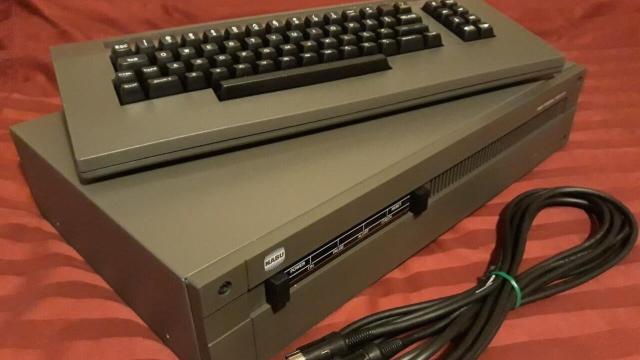Natural Access to Bi-directional Utilities. Doesn’t sound very exciting, does it? But the acronym NABU is becoming one of most interesting, burgeoning spaces for retro computer devs. Thanks to the cheap sale of these once-defunct PCs, more and more people are helping to revitalize a long-defunct cable internet service available before the days of AOL. Thanks to a newly discovered cache of machines in a barn in Massachusetts, they have accessible to anybody with around $US100 willing to buy an old-school computer straight off the rack from a barn in Massachusetts.
What’s a NABU? It’s the hottest, oldest, dumbest, smartest PC still shipping new in box thanks to a 1980s Canadian PC maker and a retired computer designer’s dream of developing a telephone exchange system with defunct Z80 processor-based PC architecture. Massachusetts man James Pellegrini has sold these PCs on eBay after keeping them in their original boxes for more than 30 years. His decision to sell these PCs for cheap has allowed the defunct PCs to have their own resurgence — bordering on a renaissance — in the retro-developer community.
Motherboard delved into the history of how these old school PCs ended up on the cutting room floor of a long-defunct Canada-based company to being sold out of a Massachusetts barn. The NABU personal computer would plug into your cable TV network and operate as a disc-less system, no OS install required. Essentially, the NABU offered a subscription that served as a precursor to cloud streaming today. All its software, games, and more would come through the network, rather than through installation discs.
NABU was ahead of its time, allowing for both downloads and uploads across its network, but it came at the wrong time, just as more companies were switching to more advanced processor architecture. The company shuttered in 1986, and Pellegrini bought a stock of 2,200 NABU computers for relatively cheap during the bankruptcy.
After trying and failing to start up a small business with the machines, he kept them around for decades, moving them from place to place, until he finally decided to try and sell them to make space. What he didn’t expect was his sale to create a whole new cottage industry of devs working on this ancient computer architecture.
YouTuber Adrian Black also delved into these strange relics of PC history late last year. His unboxing video showed that while the seller had booted up the machines to run some various tests and slip in some promotional flyers, the devices were like new in practically every way.
These devices first went on Craigslist for $US20 along with the connecting keyboards, then were sold on eBay for $US59.99, which is still dirt cheap for a new-in-the-box rare PC. That price been increased to $US99.99, while the adaptor unit that goes along with it continues to go for $US60. Pellegrini told Motherboard he sold around 560 of these computers shortly after Black released his video. After the article brought more attention to the devices, the eBay listing has since sold out.
The eBay seller said he would try and develop for the NABU PCitself once he was done shipping his stock. The main processor on the NABU is the Z80, a well-rounded 8-bit microprocessor used in PCs, consoles like the ColecoVision, in arcade games like Pac-Man, and even some music equipment like synthesizers. The system worked with two, nearly identical-looking boxes. One is the adaptor that worked as a cable modem to communicate with NABU’s network servers. The “Processor Unit” is the main unit that also comes with a keyboard.
Pellegrini had previously considered developing some ColecoVision software. Now, thanks to the hard work of some dedicated retro devs, the world is your oyster for new NABU software.
With the sudden surge of forgotten PCs out in the world, there’s more people than ever working to reconstruct the old NABU network. The NABU Network Reconstruction Project being run out of the Toronto-based York University Computer Museum offers an overview of the network and some more advice about connecting to the old cable-based protocol. The NABU RetroNET project — founded by ex-NABU software engineer Leo Binkowski and scion of NABU founder DJ Sures — is working to help users connect to the network and even help users homebrew their own content with the help of the internet adaptor. The site also has some historical resources available, and Binkowski’s own YouTube channel is dedicated to what he’s called “NABU Archaeology.”
There’s some pretty amazing stuff happening within the NABU community, too. Sures’ YouTube channel regularly features devs on the RetroNET server who have created some retro games, added a ChatGPT-like chatbot, and enabled voice synthesisation programs.
